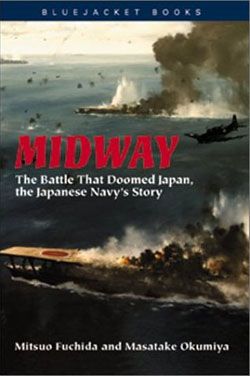“With Midway as the turning point, the fortunes of war appeared definitely to shift from our own to the Allied side. The defeat taught us many lessons and impelled our Navy, for the first time since the outbreak of war, to indulge in critical self-examination.” – Mitsuo Fuchida
It was designed to be the crowning achievement of the Imperial Japanese Navy. Fueled by memories its other great naval victories; the Battle of the Yalu River (1894), the Battle of Tsushima (1905), and the stunning victory at Pearl Harbor, this was to be the pentacle achievement as the navy would eliminate the remaining forces of the U.S. Navy Pacific Fleet.  As followers of naval tactician Alfred T. Mahan, they would draw the U.S. Navy into the decisive battle that would allow the Japanese to destroy the last threat to their dominance of the Pacific basin, the American carrier force.
As followers of naval tactician Alfred T. Mahan, they would draw the U.S. Navy into the decisive battle that would allow the Japanese to destroy the last threat to their dominance of the Pacific basin, the American carrier force.
The Japanese was anything but simple. It would comprise itself of a diversionary force that would attack the Aleutians while the main force would drive on the little island of Midway. The attack was designed to draw the American carriers into the teeth of the Japanese offensive force with 4 main battle carriers ready to take out the U.S. fleet. By the end of the battle, this great dream lay in complete shambles. The four main carriers under Admiral Nagumo had been destroyed. The majority of Japan’s first rate pilots had been killed. The Imperial Japanese Navy would no longer wield absolute dominance over the Pacific and would remain on the defensive for the rest of the war.
Midway: The Battle that Doomed Japan, the Japanese Navy’s Story examines the events and mistakes that lead to this greatest of Japanese defeats from an interesting perspective. It looks at the defeat from the Japanese perspective. Authors Mitsuo Fuchida and Masatake Okumiya both have unique insight in the battle that allows them to put together a clear picture of what was happening with the Japanese commanders. Fuchida, well known as the commander of the air fleet that attacked Pearl Harbor, was aboard the Akagi during the fateful battle having just undergone an emergency appendectomy the day they had left port. Okumiya was serving aboard the Ryujo with the Aleutian attack force allowing the two to collaborate in producing a complete picture of the fight.
The authors take their own personal experience in the battle and combine it with the official post battle work they did as well with the official U.S. Naval records on the event to put together a very complete account of the Japanese defeat. They conclude that the most responsible party in this loss falls on the shoulders of Admiral Isoroku Yamamoto. The book provides extensive analysis of the failures in Yamamoto’s plan which left Nagumo with a plan of attack too rigid to withstand any deviation or eventuality. As a result when things did begin to go wrong, there was no alternative that would readily keep the bad situation from getting worse. Yamamoto had doomed his fleet to destruction.
This book is a fascinating read for anyone who is interested in the Japanese mindset at this critical point in history. The astute reader will pick up on the cultural aspects that contributed to the failure beyond the collapse of the plan. Fuchida makes his case for Yamamoto’s responsibility for the failure, yet you still detect a sense of respect and subservice to the man in his criticisms. This can also be seen in his description of the Naval General Staff which in accordance of the chain of command should have been able to reel in Yamamoto, but were unable to oppose him because of the amount of prestige he had garnered as a result of the success at Pearl Harbor. This book illustrates that the defeat at Midway was as much a cultural defeat as it was an operational one. For anyone looking to get a broader perspective of the battle of Midway, this should be considered required reading.
CougarGA7